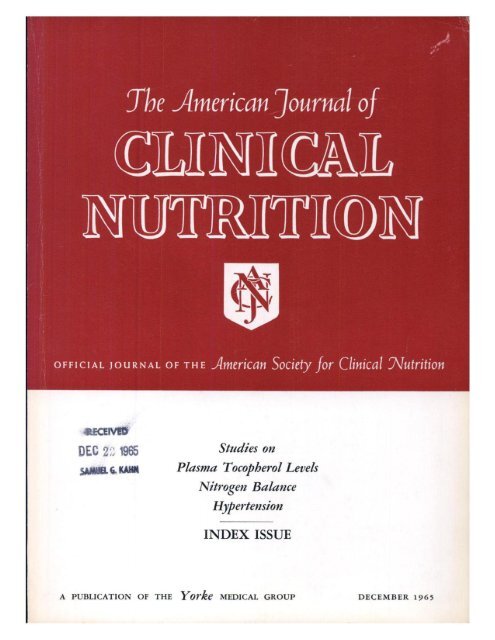使用根据体重指数调整后的小腿围预测住院患者 6 个月后再次入院和死亡率的 SARC-Calf:一项队列研究的二次分析。
IF 6.5
1区 医学
Q1 NUTRITION & DIETETICS
引用次数: 0
摘要
背景:在住院病人中,"肌肉疏松症 "是一种与临床预后恶化相关的普遍病症。SARC-Calf 是一种准确的筛查工具,但它将小腿围度 (CC) 作为一项标准,而小腿围度会受到肥胖的影响。有人提出根据体重指数(BMI)对 CC 进行调整,但文献中缺乏使用调整后的 CC 对 SARC-Calf 进行评估的研究:本研究旨在通过 BMI 调整后的 CC 评估 SARC-Calf 的预后价值,并在成年和老年住院患者之间进行比较:这是一项对前瞻性数据收集队列的二次分析,包括年龄≥18 岁、神志清醒且能够交流的患者。当体重指数(BMI)分别为 25-29.99、30-39.99 和≥ 40kg/m2 时,采用 BMI 调整 CC,从 CC 值中分别减去 3、7 和 12 厘米,得出 SARC-Calf。相关结果包括住院时间延长、院内死亡、再次入院和出院六个月后的死亡率。根据夏尔森合并症指数和性别进行调整后,进行了 Logistic 和 Cox 回归分析:我们分析了 554 名患者(平均年龄为 55.2±14.9 岁,52.9% 为男性)的数据。40.4%的患者(成人为 38.6%,老年患者为 42.7%,P=0.380)通过 SARC-Calf 和 BMI 调整后的 CC 发现了肌少症的提示性体征。在成人患者中,肌肉疏松症的可疑迹象与再入院相关(OR=1.8;95%CI 1.1-2.9),在成人患者中,肌肉疏松症的可疑迹象与六个月内死亡相关(OR=4.0;95%CI 1.3-12.1),在老年患者中,肌肉疏松症的可疑迹象与六个月内死亡相关(OR=2.8;95%CI 1.2-6.6)。结论:SARC-Calf与体重指数(BMI)无独立关联:结论:SARC-Calf与BMI调整后的CC可识别出高频率的肌肉疏松症提示体征患者,与年龄无关,且与出院后6个月的不良预后独立相关:声明:由于脂肪对小腿围(CC)测量的影响,SARC-Calf 无法准确识别高体重指数患者的提示性肌肉疏松症。在这项二次分析中,我们探讨了 SARC-Calf 与 BMI 调整后 CC 的预后价值,旨在纠正脂肪对 CC 测量的影响。我们证实,这种方法可识别出大量有肌少症提示症状的患者,并表明这种方法与成人和老年患者出院后 6 个月的不良预后密切相关。本文章由计算机程序翻译,如有差异,请以英文原文为准。
SARC-CalF using calf circumference adjusted for BMI predicts 6-mo readmission and mortality in hospitalized patients: a secondary analysis of a cohort study
Background
Sarcopenia is a prevalent condition associated with worse clinical outcomes in hospitalized patients. The SARC-CalF is an accurate instrument for its screening; however, it includes the calf circumference (CC) measure as a criterion, which is influenced by adiposity. An adjustment for CC based on body mass index (BMI) has been proposed, but the literature lacks studies evaluating the SARC-CalF using adjusted CC.
Objectives
This study aimed to evaluate the prognostic value of the SARC-CalF with BMI-adjusted CC and compare it between adult and older hospitalized patients.
Methods
This is a secondary analysis of a cohort with prospective data collection, including individuals aged ≥18 y who were lucid and able to communicate. SARC-CalF was applied using BMI-adjusted CC, obtained by subtracting 3, 7, and 12 cm from CC values when BMI was 25 to 29.99, 30 to 39.99, and ≥40 kg/m2, respectively. Outcomes of interest included prolonged hospital stay, in-hospital death, hospital readmission, and mortality 6 mo after discharge. Logistic and Cox regression analyses, adjusted for Charlson Comorbidity Index and sex, were performed.
Results
We analyzed data from 554 patients (mean age 55.2 ± 14.9 y, 52.9% male). Suggestive signs of sarcopenia by SARC-CalF with BMI-adjusted CC were identified in 40.4% of patients (38.6% of adults and 42.7% of older patients, P = 0.380). Suggestive signs of sarcopenia were associated with hospital readmission in adults (odds ratio [OR]: 1.8; 95% confidence interval [CI]: 1.1, 2.9), and 6-mo death in both adult (OR: 4.0; 95% CI: 1.3, 12.1) and older patients (OR: 2.8; 95% CI: 1.2, 6.6). It was not independently associated with in-hospital outcomes.
Conclusions
SARC-CalF with BMI-adjusted CC identifies a high frequency of patients with suggestive signs of sarcopenia, regardless of age, and it is independently associated with worse outcomes 6 mo after discharge.
求助全文
通过发布文献求助,成功后即可免费获取论文全文。
去求助
来源期刊
CiteScore
12.40
自引率
4.20%
发文量
332
审稿时长
38 days
期刊介绍:
American Journal of Clinical Nutrition is recognized as the most highly rated peer-reviewed, primary research journal in nutrition and dietetics.It focuses on publishing the latest research on various topics in nutrition, including but not limited to obesity, vitamins and minerals, nutrition and disease, and energy metabolism.
Purpose:
The purpose of AJCN is to:
Publish original research studies relevant to human and clinical nutrition.
Consider well-controlled clinical studies describing scientific mechanisms, efficacy, and safety of dietary interventions in the context of disease prevention or health benefits.
Encourage public health and epidemiologic studies relevant to human nutrition.
Promote innovative investigations of nutritional questions employing epigenetic, genomic, proteomic, and metabolomic approaches.
Include solicited editorials, book reviews, solicited or unsolicited review articles, invited controversy position papers, and letters to the Editor related to prior AJCN articles.
Peer Review Process:
All submitted material with scientific content undergoes peer review by the Editors or their designees before acceptance for publication.

 求助内容:
求助内容: 应助结果提醒方式:
应助结果提醒方式:


